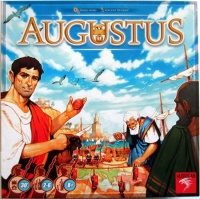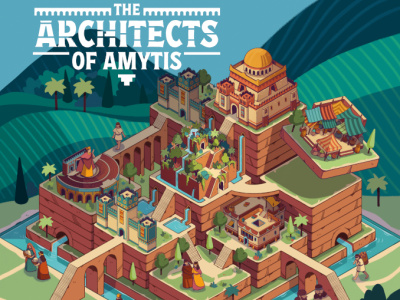 Rise of Augustus
Rise of AugustusPublisher: Hurrican (distributed in the US by Asmodee)
Release Date: August 2013
MSRP: $39.95
Designer: Paolo Mori
Number of Players: 2 to 6
Playing Time: About 30 minutes
Age Rating: 8 and up
Product #: AUG01US
ICv2 Rating: 4 Stars out of 5
The title of this game is somewhat misleading: it does not, actually, have anything to do with Augustus and his rise to power. In fact, at the point the game begins Augustus has already completed his rise. But let’s face it: "Becoming Consul" just doesn’t have the same ring to it, so I’ll let that slide. What Rise of Augustus is, on the other hand, is a great intro-level worker management game with no player downtime that plays in half an hour.
Summary: Each player assumes the role of a Roman senator, hoping to prove himself (or herself) to the emperor Augustus and be chosen as the next Consul. To earn that exalted position, the player must complete a number of "objectives" (cards) by placing "legions" (workers). Each objective is worth a number of victory points, and the player with the most points wins the game (as usual). The game ends as soon as any player completes his seventh objective.
The game mechanism is elegant and simple: one player (called the "town crier") draws a token from a bag. The token shows one of six different symbols (or a wild). All players may now place (or move) one of their legions onto a space that matches the symbol on the token. If you now have legions on all of the spaces of your objective card, you complete the objective. Completing an objective may give you an immediate bonus (usually placing more legions), and gives you some points at the end of the game.
Originality: The core system of Rise of Augustus is not revolutionary. Lots of games involve drawing a token from a bag to see what you get, and placing workers on spaces to complete objectives isn’t new either. But there are a lot of clever ideas packed into this simple, elegant game. I particularly like simultaneous play for an entry-level game like this: no down time means that less-experienced players don’t get bored.
I also really enjoyed the bonus scoring tiles: There is a series of tiles that you can earn by completing a specific number of objectives (two, three, etc.). But, each player can only claim one of these bonus tiles, and you have to decide if you’re going to claim the bonus as soon as you complete the required number of objectives. So, when you take your second objective you have to decide: do you take the two-objective bonus now? Or hope you can get one of the more valuable goals later? If you wait, you risk losing out to somebody else who gets there first. This adds a lot of tension to making your decisions in the game, as the bonus can be worth as much or more than an objective card.
Add in a few other bonuses to race for, and you end up with a surprisingly broad selection of goals to aim at--which means you have a lot of little decisions to make, and you’re not tied to one path to victory. It also means that you aren’t doomed if somebody beats you to the goal you were working towards: there are plenty of other directions you can switch to.
Presentation: The artwork is somewhat "cartoony" for my taste, but not in a way that detracts from the play of the game: the icons and symbols are all clear and easy to make out. Sadly, there is a lot of air in the box. As somebody with an overfull game shelf, I would have appreciated a box half the size without any wasted space. Maybe they’re planning expansions?
My favorite part of the game’s presentation, though, has nothing to do with any of that. In what I hope will become a trend, Rise of Augustus features an "augmented reality" feature. Those with smart phones can download the layar app and scan the box cover. An animated film pops up, in which the characters on the box come to life and describe the game to you. I always like to know what a game is about before I buy, and this video has a lot more information than you could ever print on the game box. Of course, if you don’t have a smartphone or an internet connection, you’re out of luck, unfortunately.
Quality: As one would expect from Hurrican and Asmodee, the game is manufactured from top-notch German components: nice solid box, thick sturdy tiles, cloth bag, wooden worker pieces, linen-finish cards, even a scoring pad. Rulebook is full color glossy throughout, and communicates how to play in a clear, concise manner.
Marketability: Board games have finally become socially acceptable, and they continue to grow in popularity. People who have not played a lot of games often ask me "where do I start." I can comfortably recommend Rise of Augustus as a great launching point for new game players. Yet, the game still has enough strategic decision making and tactical challenges to satisfy seasoned gamers as a light-weight "filler" game. I think that combination makes it a promising title for the market.
Overall: I really enjoyed playing Rise of Augustus. It is one of the easiest games to learn that has hit my table in a long time. I played it with a mix of seasoned gamers and casual players, and everybody had a great time playing it. I enjoyed the mix of decisions that I had to make as the game went on, and the fact that while the game has some "mean" attack moves that you can make, they don’t dominate the game or ruin the experience.
Taken as an intro game or filler title, it’s excellent. But, I think the lack of "heft," the amount of air in the box, and the relatively high price point will hamper its marketability. That’s why I have to give this game 4 out of 5.
--William Niebling







